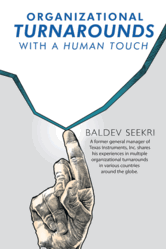Learn Proven Secrets to Successful Restructuring
Business expert shares years of experience in effective organizational turnarounds
Attleboro, MA (PRWEB) May 24, 2011
Making something more complicated does not necessarily make it better. In point of fact, in business, as with many other endeavors, the simplest solution is often the best solution. This is the first element of the simple mindset outlined in the new book Organizational Turnarounds with a Human Touch (published by Trafford Publishing) by Baldev K. Seekri.With an apt storytelling style, Seekri outlines a three-prong strategy for organizational turnaround success: simplicity first, complexity last; leadership – a basic human ability; and the theory that there is always a human solution. Seekri applies this logic to the world of business, and shows how this mindset has been applied to real world scenarios with remarkable results.
Business, regardless of what aspect one is focusing on, is all about people. Without people, whether employees, clients, consumers or partners, there can be no business. Therefore, any business plan regardless of its focus, setting or scope, must begin and end with the people involved. Organizational Turnarounds with a Human Touch concentrates on implementing simple solutions that utilize individual talents and attributes and thereby strengthen the whole.
Organizational Turnarounds with a Human Touch is as much a tool about how to utilize one’s human resources as it is a book on restructuring an organization. Using proven methods and systems, real world examples and countless success stories, Organizational Turnarounds with a Human Touch distinguishes itself as an indispensable resource on navigating the rocks and shoals of business restructuring for business professionals, management students and even individuals for self-development.
About the Author
Baldev Seekri was educated in India and the United States. He spent over forty years of his professional life turning around struggling organizations operating in diverse cultures around the globe. He retired from Texas Instruments Inc. in 2005 as general manager and lives with his wife in Attleboro, Mass.
Trafford Publishing, an Author Solutions, Inc. author services imprint, was the first publisher in the world to offer an “on-demand publishing service,” and has led the independent publishing revolution since its establishment in 1995. Trafford was also one of the earliest publishers to utilize the Internet for selling books. More than 10,000 authors from over 120 countries have utilized Trafford’s experience for self publishing their books. For more information about Trafford Publishing, or to publish your book today, call 1-888-232-4444 or visit trafford.com.
###
Contact
- Marketing Services
Trafford Publishing
1-888-232-4444
Email









